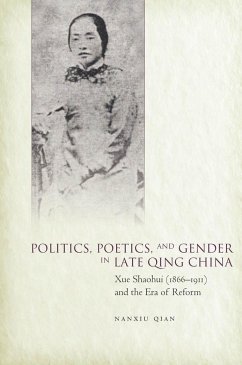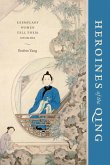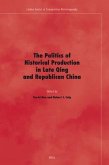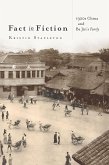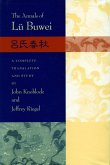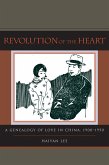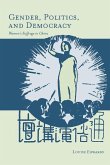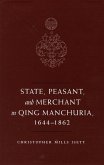- Gebundenes Buch
- Merkliste
- Auf die Merkliste
- Bewerten Bewerten
- Teilen
- Produkt teilen
- Produkterinnerung
- Produkterinnerung
Nanxiu Qian is Associate Professor of Chinese Literature at Rice University.
Andere Kunden interessierten sich auch für
![Heroines of the Qing Heroines of the Qing]() Binbin YangHeroines of the Qing54,99 €
Binbin YangHeroines of the Qing54,99 €![The Politics of Historical Production in Late Qing and Republican China The Politics of Historical Production in Late Qing and Republican China]() The Politics of Historical Production in Late Qing and Republican China194,99 €
The Politics of Historical Production in Late Qing and Republican China194,99 €![Fact in Fiction Fact in Fiction]() Kristin StapletonFact in Fiction133,99 €
Kristin StapletonFact in Fiction133,99 €![The Annals of Lü Buwei The Annals of Lü Buwei]() The Annals of Lü Buwei156,99 €
The Annals of Lü Buwei156,99 €![Revolution of the Heart Revolution of the Heart]() Haiyan LeeRevolution of the Heart144,99 €
Haiyan LeeRevolution of the Heart144,99 €![Gender, Politics, and Democracy Gender, Politics, and Democracy]() Louise EdwardsGender, Politics, and Democracy90,99 €
Louise EdwardsGender, Politics, and Democracy90,99 €![State, Peasant, and Merchant in Qing Manchuria, 1644-1862 State, Peasant, and Merchant in Qing Manchuria, 1644-1862]() Christopher M IsettState, Peasant, and Merchant in Qing Manchuria, 1644-1862101,99 €
Christopher M IsettState, Peasant, and Merchant in Qing Manchuria, 1644-1862101,99 €-
-
-
Nanxiu Qian is Associate Professor of Chinese Literature at Rice University.
Hinweis: Dieser Artikel kann nur an eine deutsche Lieferadresse ausgeliefert werden.
Hinweis: Dieser Artikel kann nur an eine deutsche Lieferadresse ausgeliefert werden.
Produktdetails
- Produktdetails
- Verlag: Stanford University Press
- Seitenzahl: 392
- Erscheinungstermin: 6. Mai 2015
- Englisch
- Abmessung: 236mm x 156mm x 30mm
- Gewicht: 666g
- ISBN-13: 9780804792400
- ISBN-10: 0804792402
- Artikelnr.: 41751490
- Verlag: Stanford University Press
- Seitenzahl: 392
- Erscheinungstermin: 6. Mai 2015
- Englisch
- Abmessung: 236mm x 156mm x 30mm
- Gewicht: 666g
- ISBN-13: 9780804792400
- ISBN-10: 0804792402
- Artikelnr.: 41751490
Nanxiu Qian is Associate Professor of Chinese Literature at Rice University.
Contents and Abstracts
Introduction
chapter abstract
The introduction presents the themes and ideas to be developed in the book.
It first reviews the strengths and weaknesses of the previous studies on
the late Qing reforms, against which it briefs the significance and the
approaches of the book (as stated in the book abstract). It then introduces
Xue's intellectual networks, which comprised of the members from her local
Min (Fujian) writing-women circles and their supportive male associates,
such as Xue's husband Chen Shoupeng (1857-c. 1928) and Shoupeng's brother
Chen Jitong (1852-1907), as well as other Min male scholars who were
related to the Fuzhou Navy Yard culture. Sustaining these women's
subjectivity was the xianyuan spirit, a legacy from the Wei-Jin era.
Literature, as the core constituent of the xianyuan and the Min
writing-women traditions, naturally became the major means for women to
advance their reform goals.
1Xue Shaohui and the Min Writing-Women Culture
chapter abstract
This chapter explores the Min writing-women culture from Xue's perspective,
based on Xue's reading of the literature and art of Min women, along with
some major critical works on their poetic accomplishments. According to
Xue, Min writing-women had been producing a culture of their own since the
mid-seventeenth century. This culture boasted the Guanglu poetic school as
its institutional manifestation and the xianyuan ideal as its intellectual
foundation. Over time, the Min writing-women tradition had been
disseminated horizontally through marital and communal ties and vertically
through the mechanism of mothers' teaching. This culture made major
contributions to the formation of Min poetics, and Min women poets
surpassed their male counterpart in poetic accomplishments. This culture
demonstrated its tenacity in the midst of the late Qing turmoil and
prepared Min writing women for their future participation in the late Qing
reforms.
2The Chen Brothers and the Fuzhou Navy Yard Culture
chapter abstract
This chapter first examines the structure of the Fuzhou Navy Yard and its
affiliated Academy that combined Chinese with Western educations, including
English- and French-language instruction in science, engineering, and naval
warfare. It then showcases the transformation of late Qing scholars by
following the Chen brothers' personal journey from the Fuzhou Naval Academy
to their scholarly and diplomatic careers in Europe. From the perspectives
of the Chen brothers, in particular Chen Jitong because of his remarkable
role in late Qing diplomatic, political, and cultural life, this chapter
looks into the constituents of the Fuzhou Navy Yard culture, focusing on
those that would have crucial influence on its future "marriage" to the Min
writing-women culture. This culture features literature as its basis, women
as its indispensable exponents, the press as its mechanism for spreading
cultural values, and democracy as its core value.
3A Marriage between the Two Cultures
chapter abstract
This chapter explores the mutual transformation of the Min writing-women
and Fuzhou Navy Yard cultures, focusing on the union of the Fuzhou girl
prodigy Xue Shaohui and the Fuzhou Naval Academy graduate Chen Shoupeng.
Shoupeng's experiences abroad introduced Xue to a much broader spectrum of
knowledge than what she had acquired from her Min writing-women upbringing,
but repeated foreign invasions at Xue's doorstep soon tarnished the
alluring luster of Western cultures. Chen Jitong's private life also
reveals the complexity of this bicultural "marriage." Such mixed exposure
to the outside world led Xue and some of her fellow Min writing women to a
lifelong journey of negotiating between the cultural values of China and
the West, enabling them to cultivate their unique visions in their future
reform career.
4The 1897-98 Shanghai Campaign for Women's Education
chapter abstract
One of the major themes of the 1898 reforms was women's education, yet for
leading male reformers women's issues tended to be subordinated to larger
nationalistic concerns. They expected women to abandon their age-long
intellectual adherence to the writing-women tradition and turn to more
pragmatic professional training, so as to change "useless" women into
laborers to empower the nation. In contrast, women reformers gave priority
to self-improvement over national empowerment, as exemplified in the 1898
Shanghai campaign for women's education. The campaign established the first
women's association in China (Nü xuehui), published the first Chinese
women's journal (Nü xuebao), and opened the first Chinese school for young
elite women (Nü xuetang), all run by women. Via this triad, women
instigated debates on reform with men and among themselves to promote their
own agenda, agency, organizations, and specific strategies for achieving
self-cultivation and national strengthening.
5Translating the Female West to Expand Chinese Women's Space
chapter abstract
After the bloody termination of the Hundred Days in 1898, Xue and Shoupeng
continued advancing the 1898 goals through translating Western literature,
histories, and science. Their most important project was the compilation of
the Biographies of Foreign Women (Waiguo lienü zhuan), the first systematic
introduction of foreign women to the Chinese readership. This chapter
argues that the Foreign Women resulted from women reformers' desire to
break the longstanding demarcation between the "inner" and "outer" domains
and to reposition the ideal "woman" in an ideal space, at home and in
society, within the intersecting frameworks of the family, the state, and
the world. In the process, foreign women's lives served not only as a model
for Chinese women but also as a collective site where different visions of
ideal womanhood were contested.
6Introducing Modern Science and Technology through Literature
chapter abstract
As part of her reform efforts in the aftermath of the Hundred Days, Xue
wrote broadly on modern science and technology when the topic had not yet
attracted attention in the literature in China. Xue employed two literary
forms to share her knowledge with Chinese readers-classical parallel prose
and the more accessible genre of quasi-vernacular fiction. This chapter
looks first at her parallel prose essays that poeticized modern science and
technology. It then examines her co-translation with Shoupeng of Jules
Verne's Around the World in Eighty Days, which marked the first Chinese
rendition of Western science fiction and the first of Jules Verne's works.
The couple's extensive annotation to the text indicates that they aimed at
translating this work into a textbook of world culture, history, and modern
science and technology. Xue's intentional rewriting of some parts further
added feminist touch to this work.
7Xue's Self-Repositioning in the Family
chapter abstract
Amid changing relationships of gender and between family and state during
the late Qing reforms, how would Xue reconsider a woman's position in the
family? How did her ideas differ from women's self-positioning in late
imperial China? Xue made clear in action and in theorization that, in
accord with the current world situation, women had to break their
cloistered position and walk into the public space. Drawing upon a broad,
eclectic pool of intellectual resources, Xue reinterpreted conventional
socio-political principles encoded in the core Confucian documents, and
revised and gendered the male-dominated polity into a cooperative
enterprise of men and women. Using Xue's personal life as an example, this
chapter examines how Xue recast women's conventional roles-wife, mother,
daughter, and sister-to fit her ideal womanhood to the changing
socio-political situation.
8Xue's Literary Response to the Late Qing Reforms
chapter abstract
This chapter probes Xue's poetic response to late Qing reforms. Her four
hundred fifty traditional-style poems literally chronicled the era. The
termination of the Hundred Days and the repressive aftermath only urged Xue
into more profound contemplation on the purpose and practice of the reform.
One major issue was women's proper positions within the guo amidst its
re-conceptualization as state, country, and/or nation-state in the reform
era. Xue would apply related ideas to her portrayal of women in the 1900
Boxer Rebellion. The final section examines Xue's last poems composed
during the New Policy campaign and the constitutional movement, when Xue
argued for a democratic republic as an ideal political structure for China.
Conclusion
chapter abstract
Despite their significant contributions to the late Qing reforms, Xue and
her cohorts were all but forgotten by the end of the dynasty, largely
because they opted for a richly nuanced culturalism rather than a
strategically oriented nationalism and were therefore written off by the
"modernizing" Chinese patriarchy. Yet the power of nationalism and the
growth of radical politics in twentieth-century China had not been able to
efface late Qing women reformers. Recent studies have come to appreciate
the multifaceted historical role of Chinese writing women. This case study
of Xue and other writing women in the reform era is intended to provoke
further explorations into the dynamism and variety of late Qing
intellectual and social life. It also serves as a reminder of the value of
the Chinese tradition, which is and has always been multidimensional,
resilient, tolerant, and capable of incorporating other traditions into its
vast repertoire.
Introduction
chapter abstract
The introduction presents the themes and ideas to be developed in the book.
It first reviews the strengths and weaknesses of the previous studies on
the late Qing reforms, against which it briefs the significance and the
approaches of the book (as stated in the book abstract). It then introduces
Xue's intellectual networks, which comprised of the members from her local
Min (Fujian) writing-women circles and their supportive male associates,
such as Xue's husband Chen Shoupeng (1857-c. 1928) and Shoupeng's brother
Chen Jitong (1852-1907), as well as other Min male scholars who were
related to the Fuzhou Navy Yard culture. Sustaining these women's
subjectivity was the xianyuan spirit, a legacy from the Wei-Jin era.
Literature, as the core constituent of the xianyuan and the Min
writing-women traditions, naturally became the major means for women to
advance their reform goals.
1Xue Shaohui and the Min Writing-Women Culture
chapter abstract
This chapter explores the Min writing-women culture from Xue's perspective,
based on Xue's reading of the literature and art of Min women, along with
some major critical works on their poetic accomplishments. According to
Xue, Min writing-women had been producing a culture of their own since the
mid-seventeenth century. This culture boasted the Guanglu poetic school as
its institutional manifestation and the xianyuan ideal as its intellectual
foundation. Over time, the Min writing-women tradition had been
disseminated horizontally through marital and communal ties and vertically
through the mechanism of mothers' teaching. This culture made major
contributions to the formation of Min poetics, and Min women poets
surpassed their male counterpart in poetic accomplishments. This culture
demonstrated its tenacity in the midst of the late Qing turmoil and
prepared Min writing women for their future participation in the late Qing
reforms.
2The Chen Brothers and the Fuzhou Navy Yard Culture
chapter abstract
This chapter first examines the structure of the Fuzhou Navy Yard and its
affiliated Academy that combined Chinese with Western educations, including
English- and French-language instruction in science, engineering, and naval
warfare. It then showcases the transformation of late Qing scholars by
following the Chen brothers' personal journey from the Fuzhou Naval Academy
to their scholarly and diplomatic careers in Europe. From the perspectives
of the Chen brothers, in particular Chen Jitong because of his remarkable
role in late Qing diplomatic, political, and cultural life, this chapter
looks into the constituents of the Fuzhou Navy Yard culture, focusing on
those that would have crucial influence on its future "marriage" to the Min
writing-women culture. This culture features literature as its basis, women
as its indispensable exponents, the press as its mechanism for spreading
cultural values, and democracy as its core value.
3A Marriage between the Two Cultures
chapter abstract
This chapter explores the mutual transformation of the Min writing-women
and Fuzhou Navy Yard cultures, focusing on the union of the Fuzhou girl
prodigy Xue Shaohui and the Fuzhou Naval Academy graduate Chen Shoupeng.
Shoupeng's experiences abroad introduced Xue to a much broader spectrum of
knowledge than what she had acquired from her Min writing-women upbringing,
but repeated foreign invasions at Xue's doorstep soon tarnished the
alluring luster of Western cultures. Chen Jitong's private life also
reveals the complexity of this bicultural "marriage." Such mixed exposure
to the outside world led Xue and some of her fellow Min writing women to a
lifelong journey of negotiating between the cultural values of China and
the West, enabling them to cultivate their unique visions in their future
reform career.
4The 1897-98 Shanghai Campaign for Women's Education
chapter abstract
One of the major themes of the 1898 reforms was women's education, yet for
leading male reformers women's issues tended to be subordinated to larger
nationalistic concerns. They expected women to abandon their age-long
intellectual adherence to the writing-women tradition and turn to more
pragmatic professional training, so as to change "useless" women into
laborers to empower the nation. In contrast, women reformers gave priority
to self-improvement over national empowerment, as exemplified in the 1898
Shanghai campaign for women's education. The campaign established the first
women's association in China (Nü xuehui), published the first Chinese
women's journal (Nü xuebao), and opened the first Chinese school for young
elite women (Nü xuetang), all run by women. Via this triad, women
instigated debates on reform with men and among themselves to promote their
own agenda, agency, organizations, and specific strategies for achieving
self-cultivation and national strengthening.
5Translating the Female West to Expand Chinese Women's Space
chapter abstract
After the bloody termination of the Hundred Days in 1898, Xue and Shoupeng
continued advancing the 1898 goals through translating Western literature,
histories, and science. Their most important project was the compilation of
the Biographies of Foreign Women (Waiguo lienü zhuan), the first systematic
introduction of foreign women to the Chinese readership. This chapter
argues that the Foreign Women resulted from women reformers' desire to
break the longstanding demarcation between the "inner" and "outer" domains
and to reposition the ideal "woman" in an ideal space, at home and in
society, within the intersecting frameworks of the family, the state, and
the world. In the process, foreign women's lives served not only as a model
for Chinese women but also as a collective site where different visions of
ideal womanhood were contested.
6Introducing Modern Science and Technology through Literature
chapter abstract
As part of her reform efforts in the aftermath of the Hundred Days, Xue
wrote broadly on modern science and technology when the topic had not yet
attracted attention in the literature in China. Xue employed two literary
forms to share her knowledge with Chinese readers-classical parallel prose
and the more accessible genre of quasi-vernacular fiction. This chapter
looks first at her parallel prose essays that poeticized modern science and
technology. It then examines her co-translation with Shoupeng of Jules
Verne's Around the World in Eighty Days, which marked the first Chinese
rendition of Western science fiction and the first of Jules Verne's works.
The couple's extensive annotation to the text indicates that they aimed at
translating this work into a textbook of world culture, history, and modern
science and technology. Xue's intentional rewriting of some parts further
added feminist touch to this work.
7Xue's Self-Repositioning in the Family
chapter abstract
Amid changing relationships of gender and between family and state during
the late Qing reforms, how would Xue reconsider a woman's position in the
family? How did her ideas differ from women's self-positioning in late
imperial China? Xue made clear in action and in theorization that, in
accord with the current world situation, women had to break their
cloistered position and walk into the public space. Drawing upon a broad,
eclectic pool of intellectual resources, Xue reinterpreted conventional
socio-political principles encoded in the core Confucian documents, and
revised and gendered the male-dominated polity into a cooperative
enterprise of men and women. Using Xue's personal life as an example, this
chapter examines how Xue recast women's conventional roles-wife, mother,
daughter, and sister-to fit her ideal womanhood to the changing
socio-political situation.
8Xue's Literary Response to the Late Qing Reforms
chapter abstract
This chapter probes Xue's poetic response to late Qing reforms. Her four
hundred fifty traditional-style poems literally chronicled the era. The
termination of the Hundred Days and the repressive aftermath only urged Xue
into more profound contemplation on the purpose and practice of the reform.
One major issue was women's proper positions within the guo amidst its
re-conceptualization as state, country, and/or nation-state in the reform
era. Xue would apply related ideas to her portrayal of women in the 1900
Boxer Rebellion. The final section examines Xue's last poems composed
during the New Policy campaign and the constitutional movement, when Xue
argued for a democratic republic as an ideal political structure for China.
Conclusion
chapter abstract
Despite their significant contributions to the late Qing reforms, Xue and
her cohorts were all but forgotten by the end of the dynasty, largely
because they opted for a richly nuanced culturalism rather than a
strategically oriented nationalism and were therefore written off by the
"modernizing" Chinese patriarchy. Yet the power of nationalism and the
growth of radical politics in twentieth-century China had not been able to
efface late Qing women reformers. Recent studies have come to appreciate
the multifaceted historical role of Chinese writing women. This case study
of Xue and other writing women in the reform era is intended to provoke
further explorations into the dynamism and variety of late Qing
intellectual and social life. It also serves as a reminder of the value of
the Chinese tradition, which is and has always been multidimensional,
resilient, tolerant, and capable of incorporating other traditions into its
vast repertoire.
Contents and Abstracts
Introduction
chapter abstract
The introduction presents the themes and ideas to be developed in the book.
It first reviews the strengths and weaknesses of the previous studies on
the late Qing reforms, against which it briefs the significance and the
approaches of the book (as stated in the book abstract). It then introduces
Xue's intellectual networks, which comprised of the members from her local
Min (Fujian) writing-women circles and their supportive male associates,
such as Xue's husband Chen Shoupeng (1857-c. 1928) and Shoupeng's brother
Chen Jitong (1852-1907), as well as other Min male scholars who were
related to the Fuzhou Navy Yard culture. Sustaining these women's
subjectivity was the xianyuan spirit, a legacy from the Wei-Jin era.
Literature, as the core constituent of the xianyuan and the Min
writing-women traditions, naturally became the major means for women to
advance their reform goals.
1Xue Shaohui and the Min Writing-Women Culture
chapter abstract
This chapter explores the Min writing-women culture from Xue's perspective,
based on Xue's reading of the literature and art of Min women, along with
some major critical works on their poetic accomplishments. According to
Xue, Min writing-women had been producing a culture of their own since the
mid-seventeenth century. This culture boasted the Guanglu poetic school as
its institutional manifestation and the xianyuan ideal as its intellectual
foundation. Over time, the Min writing-women tradition had been
disseminated horizontally through marital and communal ties and vertically
through the mechanism of mothers' teaching. This culture made major
contributions to the formation of Min poetics, and Min women poets
surpassed their male counterpart in poetic accomplishments. This culture
demonstrated its tenacity in the midst of the late Qing turmoil and
prepared Min writing women for their future participation in the late Qing
reforms.
2The Chen Brothers and the Fuzhou Navy Yard Culture
chapter abstract
This chapter first examines the structure of the Fuzhou Navy Yard and its
affiliated Academy that combined Chinese with Western educations, including
English- and French-language instruction in science, engineering, and naval
warfare. It then showcases the transformation of late Qing scholars by
following the Chen brothers' personal journey from the Fuzhou Naval Academy
to their scholarly and diplomatic careers in Europe. From the perspectives
of the Chen brothers, in particular Chen Jitong because of his remarkable
role in late Qing diplomatic, political, and cultural life, this chapter
looks into the constituents of the Fuzhou Navy Yard culture, focusing on
those that would have crucial influence on its future "marriage" to the Min
writing-women culture. This culture features literature as its basis, women
as its indispensable exponents, the press as its mechanism for spreading
cultural values, and democracy as its core value.
3A Marriage between the Two Cultures
chapter abstract
This chapter explores the mutual transformation of the Min writing-women
and Fuzhou Navy Yard cultures, focusing on the union of the Fuzhou girl
prodigy Xue Shaohui and the Fuzhou Naval Academy graduate Chen Shoupeng.
Shoupeng's experiences abroad introduced Xue to a much broader spectrum of
knowledge than what she had acquired from her Min writing-women upbringing,
but repeated foreign invasions at Xue's doorstep soon tarnished the
alluring luster of Western cultures. Chen Jitong's private life also
reveals the complexity of this bicultural "marriage." Such mixed exposure
to the outside world led Xue and some of her fellow Min writing women to a
lifelong journey of negotiating between the cultural values of China and
the West, enabling them to cultivate their unique visions in their future
reform career.
4The 1897-98 Shanghai Campaign for Women's Education
chapter abstract
One of the major themes of the 1898 reforms was women's education, yet for
leading male reformers women's issues tended to be subordinated to larger
nationalistic concerns. They expected women to abandon their age-long
intellectual adherence to the writing-women tradition and turn to more
pragmatic professional training, so as to change "useless" women into
laborers to empower the nation. In contrast, women reformers gave priority
to self-improvement over national empowerment, as exemplified in the 1898
Shanghai campaign for women's education. The campaign established the first
women's association in China (Nü xuehui), published the first Chinese
women's journal (Nü xuebao), and opened the first Chinese school for young
elite women (Nü xuetang), all run by women. Via this triad, women
instigated debates on reform with men and among themselves to promote their
own agenda, agency, organizations, and specific strategies for achieving
self-cultivation and national strengthening.
5Translating the Female West to Expand Chinese Women's Space
chapter abstract
After the bloody termination of the Hundred Days in 1898, Xue and Shoupeng
continued advancing the 1898 goals through translating Western literature,
histories, and science. Their most important project was the compilation of
the Biographies of Foreign Women (Waiguo lienü zhuan), the first systematic
introduction of foreign women to the Chinese readership. This chapter
argues that the Foreign Women resulted from women reformers' desire to
break the longstanding demarcation between the "inner" and "outer" domains
and to reposition the ideal "woman" in an ideal space, at home and in
society, within the intersecting frameworks of the family, the state, and
the world. In the process, foreign women's lives served not only as a model
for Chinese women but also as a collective site where different visions of
ideal womanhood were contested.
6Introducing Modern Science and Technology through Literature
chapter abstract
As part of her reform efforts in the aftermath of the Hundred Days, Xue
wrote broadly on modern science and technology when the topic had not yet
attracted attention in the literature in China. Xue employed two literary
forms to share her knowledge with Chinese readers-classical parallel prose
and the more accessible genre of quasi-vernacular fiction. This chapter
looks first at her parallel prose essays that poeticized modern science and
technology. It then examines her co-translation with Shoupeng of Jules
Verne's Around the World in Eighty Days, which marked the first Chinese
rendition of Western science fiction and the first of Jules Verne's works.
The couple's extensive annotation to the text indicates that they aimed at
translating this work into a textbook of world culture, history, and modern
science and technology. Xue's intentional rewriting of some parts further
added feminist touch to this work.
7Xue's Self-Repositioning in the Family
chapter abstract
Amid changing relationships of gender and between family and state during
the late Qing reforms, how would Xue reconsider a woman's position in the
family? How did her ideas differ from women's self-positioning in late
imperial China? Xue made clear in action and in theorization that, in
accord with the current world situation, women had to break their
cloistered position and walk into the public space. Drawing upon a broad,
eclectic pool of intellectual resources, Xue reinterpreted conventional
socio-political principles encoded in the core Confucian documents, and
revised and gendered the male-dominated polity into a cooperative
enterprise of men and women. Using Xue's personal life as an example, this
chapter examines how Xue recast women's conventional roles-wife, mother,
daughter, and sister-to fit her ideal womanhood to the changing
socio-political situation.
8Xue's Literary Response to the Late Qing Reforms
chapter abstract
This chapter probes Xue's poetic response to late Qing reforms. Her four
hundred fifty traditional-style poems literally chronicled the era. The
termination of the Hundred Days and the repressive aftermath only urged Xue
into more profound contemplation on the purpose and practice of the reform.
One major issue was women's proper positions within the guo amidst its
re-conceptualization as state, country, and/or nation-state in the reform
era. Xue would apply related ideas to her portrayal of women in the 1900
Boxer Rebellion. The final section examines Xue's last poems composed
during the New Policy campaign and the constitutional movement, when Xue
argued for a democratic republic as an ideal political structure for China.
Conclusion
chapter abstract
Despite their significant contributions to the late Qing reforms, Xue and
her cohorts were all but forgotten by the end of the dynasty, largely
because they opted for a richly nuanced culturalism rather than a
strategically oriented nationalism and were therefore written off by the
"modernizing" Chinese patriarchy. Yet the power of nationalism and the
growth of radical politics in twentieth-century China had not been able to
efface late Qing women reformers. Recent studies have come to appreciate
the multifaceted historical role of Chinese writing women. This case study
of Xue and other writing women in the reform era is intended to provoke
further explorations into the dynamism and variety of late Qing
intellectual and social life. It also serves as a reminder of the value of
the Chinese tradition, which is and has always been multidimensional,
resilient, tolerant, and capable of incorporating other traditions into its
vast repertoire.
Introduction
chapter abstract
The introduction presents the themes and ideas to be developed in the book.
It first reviews the strengths and weaknesses of the previous studies on
the late Qing reforms, against which it briefs the significance and the
approaches of the book (as stated in the book abstract). It then introduces
Xue's intellectual networks, which comprised of the members from her local
Min (Fujian) writing-women circles and their supportive male associates,
such as Xue's husband Chen Shoupeng (1857-c. 1928) and Shoupeng's brother
Chen Jitong (1852-1907), as well as other Min male scholars who were
related to the Fuzhou Navy Yard culture. Sustaining these women's
subjectivity was the xianyuan spirit, a legacy from the Wei-Jin era.
Literature, as the core constituent of the xianyuan and the Min
writing-women traditions, naturally became the major means for women to
advance their reform goals.
1Xue Shaohui and the Min Writing-Women Culture
chapter abstract
This chapter explores the Min writing-women culture from Xue's perspective,
based on Xue's reading of the literature and art of Min women, along with
some major critical works on their poetic accomplishments. According to
Xue, Min writing-women had been producing a culture of their own since the
mid-seventeenth century. This culture boasted the Guanglu poetic school as
its institutional manifestation and the xianyuan ideal as its intellectual
foundation. Over time, the Min writing-women tradition had been
disseminated horizontally through marital and communal ties and vertically
through the mechanism of mothers' teaching. This culture made major
contributions to the formation of Min poetics, and Min women poets
surpassed their male counterpart in poetic accomplishments. This culture
demonstrated its tenacity in the midst of the late Qing turmoil and
prepared Min writing women for their future participation in the late Qing
reforms.
2The Chen Brothers and the Fuzhou Navy Yard Culture
chapter abstract
This chapter first examines the structure of the Fuzhou Navy Yard and its
affiliated Academy that combined Chinese with Western educations, including
English- and French-language instruction in science, engineering, and naval
warfare. It then showcases the transformation of late Qing scholars by
following the Chen brothers' personal journey from the Fuzhou Naval Academy
to their scholarly and diplomatic careers in Europe. From the perspectives
of the Chen brothers, in particular Chen Jitong because of his remarkable
role in late Qing diplomatic, political, and cultural life, this chapter
looks into the constituents of the Fuzhou Navy Yard culture, focusing on
those that would have crucial influence on its future "marriage" to the Min
writing-women culture. This culture features literature as its basis, women
as its indispensable exponents, the press as its mechanism for spreading
cultural values, and democracy as its core value.
3A Marriage between the Two Cultures
chapter abstract
This chapter explores the mutual transformation of the Min writing-women
and Fuzhou Navy Yard cultures, focusing on the union of the Fuzhou girl
prodigy Xue Shaohui and the Fuzhou Naval Academy graduate Chen Shoupeng.
Shoupeng's experiences abroad introduced Xue to a much broader spectrum of
knowledge than what she had acquired from her Min writing-women upbringing,
but repeated foreign invasions at Xue's doorstep soon tarnished the
alluring luster of Western cultures. Chen Jitong's private life also
reveals the complexity of this bicultural "marriage." Such mixed exposure
to the outside world led Xue and some of her fellow Min writing women to a
lifelong journey of negotiating between the cultural values of China and
the West, enabling them to cultivate their unique visions in their future
reform career.
4The 1897-98 Shanghai Campaign for Women's Education
chapter abstract
One of the major themes of the 1898 reforms was women's education, yet for
leading male reformers women's issues tended to be subordinated to larger
nationalistic concerns. They expected women to abandon their age-long
intellectual adherence to the writing-women tradition and turn to more
pragmatic professional training, so as to change "useless" women into
laborers to empower the nation. In contrast, women reformers gave priority
to self-improvement over national empowerment, as exemplified in the 1898
Shanghai campaign for women's education. The campaign established the first
women's association in China (Nü xuehui), published the first Chinese
women's journal (Nü xuebao), and opened the first Chinese school for young
elite women (Nü xuetang), all run by women. Via this triad, women
instigated debates on reform with men and among themselves to promote their
own agenda, agency, organizations, and specific strategies for achieving
self-cultivation and national strengthening.
5Translating the Female West to Expand Chinese Women's Space
chapter abstract
After the bloody termination of the Hundred Days in 1898, Xue and Shoupeng
continued advancing the 1898 goals through translating Western literature,
histories, and science. Their most important project was the compilation of
the Biographies of Foreign Women (Waiguo lienü zhuan), the first systematic
introduction of foreign women to the Chinese readership. This chapter
argues that the Foreign Women resulted from women reformers' desire to
break the longstanding demarcation between the "inner" and "outer" domains
and to reposition the ideal "woman" in an ideal space, at home and in
society, within the intersecting frameworks of the family, the state, and
the world. In the process, foreign women's lives served not only as a model
for Chinese women but also as a collective site where different visions of
ideal womanhood were contested.
6Introducing Modern Science and Technology through Literature
chapter abstract
As part of her reform efforts in the aftermath of the Hundred Days, Xue
wrote broadly on modern science and technology when the topic had not yet
attracted attention in the literature in China. Xue employed two literary
forms to share her knowledge with Chinese readers-classical parallel prose
and the more accessible genre of quasi-vernacular fiction. This chapter
looks first at her parallel prose essays that poeticized modern science and
technology. It then examines her co-translation with Shoupeng of Jules
Verne's Around the World in Eighty Days, which marked the first Chinese
rendition of Western science fiction and the first of Jules Verne's works.
The couple's extensive annotation to the text indicates that they aimed at
translating this work into a textbook of world culture, history, and modern
science and technology. Xue's intentional rewriting of some parts further
added feminist touch to this work.
7Xue's Self-Repositioning in the Family
chapter abstract
Amid changing relationships of gender and between family and state during
the late Qing reforms, how would Xue reconsider a woman's position in the
family? How did her ideas differ from women's self-positioning in late
imperial China? Xue made clear in action and in theorization that, in
accord with the current world situation, women had to break their
cloistered position and walk into the public space. Drawing upon a broad,
eclectic pool of intellectual resources, Xue reinterpreted conventional
socio-political principles encoded in the core Confucian documents, and
revised and gendered the male-dominated polity into a cooperative
enterprise of men and women. Using Xue's personal life as an example, this
chapter examines how Xue recast women's conventional roles-wife, mother,
daughter, and sister-to fit her ideal womanhood to the changing
socio-political situation.
8Xue's Literary Response to the Late Qing Reforms
chapter abstract
This chapter probes Xue's poetic response to late Qing reforms. Her four
hundred fifty traditional-style poems literally chronicled the era. The
termination of the Hundred Days and the repressive aftermath only urged Xue
into more profound contemplation on the purpose and practice of the reform.
One major issue was women's proper positions within the guo amidst its
re-conceptualization as state, country, and/or nation-state in the reform
era. Xue would apply related ideas to her portrayal of women in the 1900
Boxer Rebellion. The final section examines Xue's last poems composed
during the New Policy campaign and the constitutional movement, when Xue
argued for a democratic republic as an ideal political structure for China.
Conclusion
chapter abstract
Despite their significant contributions to the late Qing reforms, Xue and
her cohorts were all but forgotten by the end of the dynasty, largely
because they opted for a richly nuanced culturalism rather than a
strategically oriented nationalism and were therefore written off by the
"modernizing" Chinese patriarchy. Yet the power of nationalism and the
growth of radical politics in twentieth-century China had not been able to
efface late Qing women reformers. Recent studies have come to appreciate
the multifaceted historical role of Chinese writing women. This case study
of Xue and other writing women in the reform era is intended to provoke
further explorations into the dynamism and variety of late Qing
intellectual and social life. It also serves as a reminder of the value of
the Chinese tradition, which is and has always been multidimensional,
resilient, tolerant, and capable of incorporating other traditions into its
vast repertoire.
